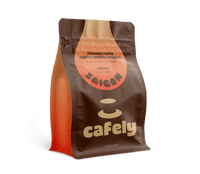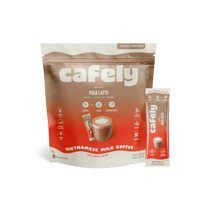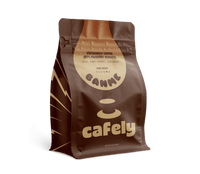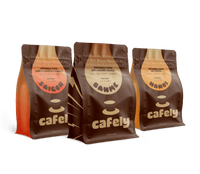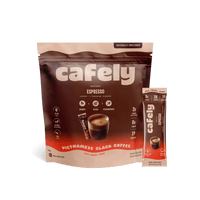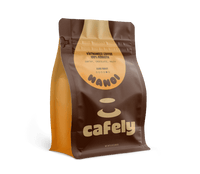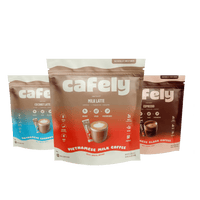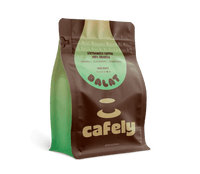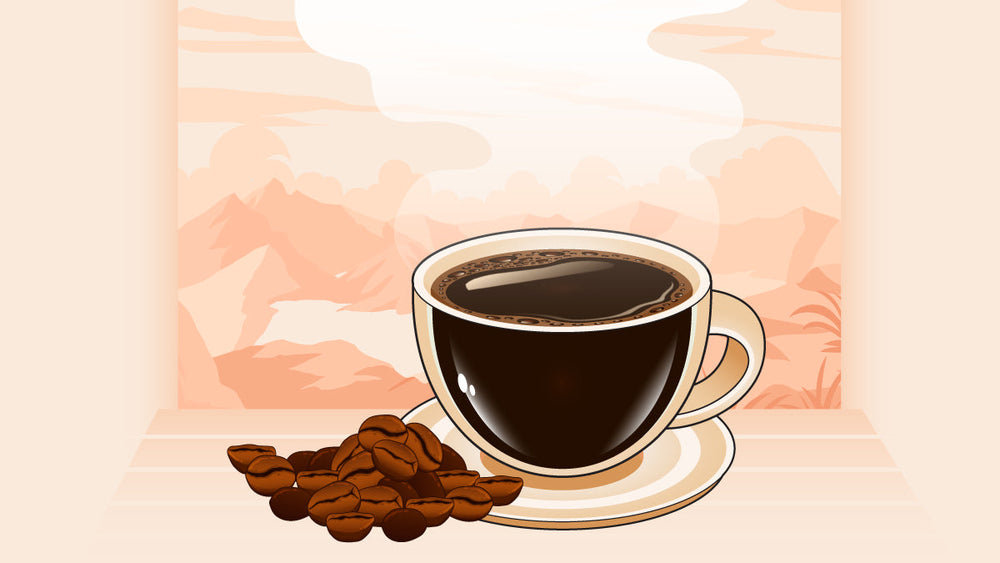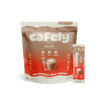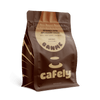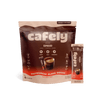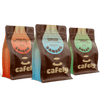Java coffee is from the island of Java in Indonesia — an island nation in Southeast Asia. Indonesia is the fourth biggest producer of coffee in the world, and Java produces a large percentage of the country’s coffee.
In this guide, you’ll learn all about Java coffee, including what type of beans they are, how they taste, what makes Java coffee unique, and the best way to brew it.
What is Java Coffee?
Java coffee is coffee that’s grown on the island of Java in Indonesia. The coffee beans produced in Java tend to have a lower acidity and richer flavor profile than those from South America and Africa. It’s the island’s high altitudes, nutrient-rich volcanic soil, and warm, wet climate that contribute to its coffee quality.
Only around 10% of Java’s coffee bean production is arabica variety, the remaining 90% is robusta beans. The rare but prized Java arabica beans fetch some of the highest coffee prices in the world. Its robusta and blends are also popular for their quality.
What Does Java Coffee Taste Like?

Java coffee has complex flavor profiles. The flavor and aroma of Java coffee depend on its type — arabica coffee is generally smoother, and robusta is much more bold.
Here’s how arabica and robusta coffee from Java compare:
1. Java Arabica Coffee
Java arabica coffee is known for its smooth and well-balanced flavor profile. It has a full body, moderate acidity, and subtle notes of chocolate, nuts, and spices. You may also detect earthy, herby, and floral undertones — this is thanks to the volcanic soils of Java.
Java Arabica is often favored by those who enjoy refined, nuanced flavors without overwhelming bitterness.
2. Java Robusta Coffee
Java robusta coffee is bold, rich, and intense. It has a heavier body than arabica as well as a higher caffeine content (about twice as much).
It’s even less acidic than Java arabica, making it the perfect choice for milky hot brews and sweet, bold iced coffees and cold brews. Its flavor profile often includes woody and earthy tones, with a hint of bitterness.
Many coffee drinkers in Southeast Asia prize this robust flavor profile but it's often “too strong” for Western coffee drinkers who are used to arabica. With that said, most people will enjoy the bold flavors of Java robusta if it's prepared correctly and sweetened with milk, sugar, or syrup.
3. Blends From Java
Blends made from robusta and arabica have the qualities of both beans. Blends produce a perfectly balanced cup of coffee. They are remarkably versatile and the perfect choice for crafting daily brews using various techniques.
Blends are smooth and naturally sweet like arabica and dark, bold, and slightly bitter like robusta. Blends aren't as strong as 100% robusta but they do contain a higher caffeine content than 100% arabica.
Why is Java Coffee Popular?
Java coffee is highly prized for several reasons. Its origin, quality, processing methods, and limited production all make Java coffee a sought-after choice for coffee connoisseurs around the world.
Here’s why Java coffee is so popular:
1. Limited Production
Although Indonesia is the fourth largest coffee-producing nation in the world, Java’s coffee output is relatively low. The island is made up of cooperatives and smallholders which produce small amounts of high-quality coffee.
Arabica crops on the island make up a tiny percentage of its coffee production, making Java arabica beans scarce. This scarcity enhances its appeal and gives the coffee a sense of “exclusivity” — raising its status among coffee enthusiasts.
2. Unique Processing Methods
Most Java coffee beans are processed using a traditional wet-hulling technique. Wet-hulling is the process of removing the protective parchment layer of the coffee bean before it’s dried.
This method retains the unique earthy, floral, and herby characteristics the raw coffee cherries have. After roasting, wet-hulled beans produce brews with a thick, complex body and extremely low acidity.
The bold flavors produced by wet-hulled coffee make them perfect for espresso blends and use in cold brews.
3. Unique Flavor Profile
Java coffee is known for its smooth, full-bodied flavor with low acidity and notes of spice, earthiness, and chocolate. These bold flavors (in part) come from the wet-hulling processing method. However, many of the flavors are produced from the unique growing environment.
The volcanic soil and wet, humid, tropical climate of Java contribute to its distinctive taste. The high altitude, warm weather, and high-quality soil are unlike any other coffee-growing country in the world, giving Java coffee a unique flavor profile.
4. Rich History of Coffee Production
The island of Java in Indonesia was one of the first places where coffee was cultivated commercially.
During the Dutch colonial period in the 17th century, the Dutch introduced coffee plants from Yemen to Java. It was one of the first regions outside of Africa and Arabia to cultivate coffee on a large scale.
During the 18th century, much of the world’s coffee supply came from Java. The strong association with coffee and the region is why “Java” became a generic term for coffee in many parts of the world.
This long-standing history is appealing to many coffee connoisseurs. The arabica strains — especially the Typica cultivar — that survived the famous coffee rust disease of the late 1800s are some of the oldest. This rich history and heritage is what attracts many coffee enthusiasts to Java coffee.
How to Brew Java Coffee: Three Different Ways
You can brew Java coffee using your favorite brewing method. However, a few different methods make the unique characteristics of these high-quality beans shine.
Here’s how to brew a balanced cup of Java coffee, in three ways:
1. Brewing Java Coffee With a Moka Pot

The moka pot produces espresso-like coffee without the use of electricity. This brewer forces hot water up through finely ground coffee, producing a bold yet delicate shot of coffee that highlights the island flavors of Java.
Here's what you need to brew Java coffee with a moka pot:
- Moka Pot — Moka pots are available in a range of sizes from 1–12 cups (60–800 mL).
- Coffee Grinder — The best Java is whole-bean. You’ll need a grinder to grind these beans before brewing. A burr grinder produces the most consistent fine grind.
- Coffee Measure — A coffee measure allows you to accurately measure the ground coffee. This is essential if you want to make great-tasting Java every time.
- Java Coffee — Opt for a high-quality, whole-bean Java arabica.
- Water — Opt for fresh, cold, filtered water. Avoid using tap water in your moka pot; this can cause mineral build-up over time.
Here's how to make Java coffee with a moka pot:
1. Measure and Grind the Coffee
First, you’ll need to measure and grind your Java coffee. For one shot (60 mL) of moka pot coffee, you’ll need around six grams of ground coffee.
Grind the coffee to a fine grind — around the same consistency as table salt or sand.
2. Prepare the Moka Pot
Fill the bottom chamber (water chamber) of your moka pot with water. For every six grams of coffee, you’ll need 60 mL of water. Most moka pots have a fill line in the bottom chamber.
Fill the filter basket with your ground Java coffee and level it using the back of a spoon. Avoid tamping the grounds, they should be loosely packed for an even extraction. Place the filter basket into the bottom chamber.
Screw on the top chamber (collection chamber) securely and place it on your stove.
3. Wait for the Pot to Start Brewing
Turn your stove on and wait for the moka pot to start “gurgling” — this is the water beginning to boil. This will take two to five minutes depending on the volume of water in the bottom chamber.
4. Reduce the Heat
Check the collection chamber and check to make sure the brew is dripping through the spout. Then, reduce the heat to low and wait for the coffee to brew.
When the pot starts spluttering loudly, the pot has finished brewing. Remove the moka pot from the heat.
5. Pour and Enjoy
Gently pour up your moka coffee. Enjoy the shot like an espresso. Alternatively, you can add milk to create a latte-like brew or extra water to create an Americano coffee.
2. Brewing Java Coffee With a Pour-Over

Pour-over coffee brewers such as the Hario V60 work similarly to drip coffee makers. However, they offer far more control over flow rate, water temperature, and extraction time which can create a more defined cup of coffee.
Here's what you need to brew Java with a pour-over coffee maker:
- Pour-Over Brewer — Pour-over brewers come in different shapes and sizes but they all work similarly.
- Coffee Grinder — The best Java coffee is whole-bean, so you’ll need a coffee grinder. A burr grinder will achieve the medium-fine consistency needed for most pour-over setups.
- Coffee Measure — A coffee measure or weighing scale allows you to accurately measure the ground coffee, ensuring you create the perfect brew every time.
- Kettle — You’ll need to boil water to make pour-over coffee. An electric or stovetop kettle will achieve this.
- Java Coffee — Opt for a high-quality whole-bean Java coffee. You can use arabica or robusta for pour-over.
- Water — Use fresh, filtered water for the best cup of Java.
Here's how to make Java coffee with a pour-over:
1. Boil a Kettle of Water
First, boil a kettle of fresh, filtered water. Most pour-over setups require a 1:15 to 1:2 coffee-to-water ratio. You’ll need enough water for the amount of coffee you’re using as well as extra for pre-heating and soaking the filter.
2. Measure and Grind the Coffee
Next, grind your Java coffee. You can use robusta, arabica, or a blend in a pour-over — which type you select depends on your taste.
For every 8 oz (240 mL) cup of coffee, you’ll need around 25 grams of coffee. Once you’ve measured your coffee beans, grind them to a medium-fine consistency similar to table salt or sand.
3. Prepare the Pour-Over Brewer
Place a filter in the brewing chamber of your pour-over. Pour in a small amount of hot water to pre-soak the filter.
Let the water drip through into the collection chamber, swirl, and discard. This will remove impurities from the paper coffee filter and pre-heat the brewing equipment.
4. Bloom the Coffee
Add your coffee to the filter and disperse evenly. Pour just enough water to cover the grounds and wait for 30 seconds to one minute to allow the gasses to escape. This is known as “blooming” the coffee and results in a more even extraction.
5. Brew the Coffee
Once you’ve bloomed the coffee, add the rest of your water. Move in a gentle circular motion to ensure the grounds are fully submerged with the least amount of disturbance.
After 30 seconds or so, you’ll see the first drips pass through the filter. Wait for all of the water to pass through the coffee — this can take anywhere from three to five minutes depending on the setup you have.
6. Pour, Serve, and Enjoy
Once the final drops of coffee have dripped through the filter, remove the brewing chamber and discard the spent grounds.
Pour your coffee into your favorite coffee mug and enjoy. You can add sugar and milk to taste if desired.
3. Brewing Cold Brew Java Coffee

Cold brew is made by brewing ground coffee in cold water for an extended period of time. This brewing method results in a low-acidity cup of coffee that highlights the delicate flavors of high-quality Java coffee. Cold brew can be made using a French press or a glass jar and coffee strainer.
Here's what you need to make cold brew from Java coffee:
- French Press — A French press is the most convenient coffee brewer for making Java cold brew. They’re available in a range of shapes and sizes.
- Coffee Grinder — You’ll need a grinder to grind your Java coffee beans to a coarse consistency.
- Coffee Measure — A measure or weigh scale allows you to accurately measure your coffee every time you make a pot of cold brew.
- Java Coffee — Opt for a whole-bean arabica Java coffee for a sweet, mild cold brew. Choose a robusta for a dark, bold cold brew.
- Water — Use cold, fresh, filtered water for making cold brew.
Here's how to make cold brew coffee with Java beans:
1. Measure and Grind the Coffee
First, measure and properly grind your coffee. The amount of coffee you’ll need depends on the amount of cold brew coffee you wish to make.
You need around 27 grams of coffee for every 8 oz (240 mL) of water.
Once you’ve measured your coffee beans, grind them coarse — a similar consistency to sea salt.
2. Combine the Coffee and Water
Add the ground coffee to your French press followed by the appropriate amount of cold, fresh, filtered water. Stir the grounds gently until they’re incorporated.
3. Let the Brew Steep
Attach the lid on your French press and place the brew in your refrigerator. Leave the coffee to brew for 18 to 24 hours. The longer you leave the brew, the stronger it will become.
4. Strain the Brew
After 18 to 24 hours, remove the French press from the fridge and gently push the plunger down to separate the grounds.
If you wish to store the cold brew, pour it into a separate container and discard the spent coffee grounds. Leaving the brew with the grounds in the French press will eventually lead to over-extraction.
Cold brew can be kept in the fridge for three to four days before it begins to lose flavor.
5. Serve and Enjoy
When you’re ready to drink your cold brew, pour it into a glass. Add ice to chill the brew further. You can also add milk and syrup if you want to make a creamy, sweet, iced coffee.
How Does Java Coffee Compare to Other World Coffee
Java has a reputation for producing some of the finest coffee beans on the planet. So, how does it compare to coffee from other countries?
Here are the top coffee-producing countries, what makes their beans unique, and how they compare to Java coffee:
1. Vietnamese Coffee
Vietnam is the world’s second-largest coffee producer with a global production of around 16% (27.5 million 60 kg bags) per year. It’s the largest producer of robusta coffee — a bean known for its bold flavor, high caffeine content, and nutty, earthy, and slightly bitter notes.
Vietnamese robusta coffee is often combined with sweetened condensed milk. The sweet creaminess of this dairy product balances the strong flavors of robusta.
Java robusta shares similar boldness and earthiness to Vietnamese robusta. However, Java’s beans can be slightly less bitter due to the traditional wet-hulling process.
2. Ethiopian Coffee
Ethiopia is believed to be the birthplace of coffee. This nation is the fourth largest coffee producer with a global production of around 5% (8.6 million 60 kg bags) per year. Ethiopia produces arabica coffee.
Ethiopian arabica coffee is famous for its fruity, floral, and wine-like flavors. They tend to have a stronger acidity and often produce a citrusy taste and mouthfeel because of it.
Ethiopian arabica coffee is brighter and more fruit-forward compared to the earthy and spiced characteristics of Java arabica. Java coffee is more full-bodied and much less acidic, offering a more balanced flavor experience.
3. Colombian Coffee
Colombia is the third largest coffee producer and the second largest arabica producer. It has a global production of 8% (12.76 million bags).
Colombian arabica coffee is famed for its smooth and mild flavor. These beans are well-balanced, with a mild acidity and flavors of nuts, caramel, and fruit. Colombian coffee is a great “all-rounder” because of its approachable and versatile flavor profile.
Java arabica tends to have a more robust flavor profile compared to Colombian arabica which is much more subtle and delicate. Colombian beans may appeal to those seeking a milder cup of coffee, while Java beans cater to those who prefer depth and richness.
4. Brazilian Coffee
Brazil is the largest coffee producer in the world, with a global production of 39% and a staggering 66.3 million bags of coffee produced each year. Brazil grows large volumes of both arabica and robusta. However, it’s most known for arabica.
Brazilian arabica coffee can vary widely in flavor and body due to the diverse range of environments it's grown. However, it’s generally known for its nutty, chocolatey notes with a low acidity and medium body. Brazilian arabica and blends are often used for making espresso.
Both Java and Brazilian coffees share chocolatey undertones, but Java arabica tends to have spicier and earthier undertones. Java robusta is also bolder than the typical Brazilian robusta which tends to have a mellower flavor profile.
5. Honduras Coffee
Honduras is the eighth largest coffee producer in the world, with a global production of 3% — around five million bags per year. Honduras produces high-quality arabica coffee that’s famed for its sweet, creamy flavors and notes of tropical fruit, caramel, and chocolate.
Honduran coffee has gained recognition for its balanced and approachable profile and unique flavor notes.
Compared to Java arabica, Honduran coffee is more acidic and much brighter, sweeter, and fruitier, appealing to those who prefer a lighter cup of coffee. Java coffee has a more robust flavor, with a heavier body and lower acidity, appealing to those who prefer a richer, deeper cup.
FAQs: What is Java Coffee?
Want to learn more about Java coffee and other types of coffee?
Check out the answers to the FAQs below or head over to the Cafely Blog.
1. What Type of Coffee is Java?
Java coffee is coffee made from beans grown and processed on the island of Java in Indonesia. However, when most people refer to “Java” coffee they’re referring to arabica beans from the island. Although 90% of the coffee grown on Java is robusta coffee beans, arabica is the most sought-after coffee in the region.
2. What's the Difference Between Arabica and Robusta Coffee?
Arabica and robusta are two types of coffee beans from two unique species — Coffea arabica and Coffea robusta. Arabica beans create a smooth, naturally sweet brew with a mild caffeine content. Robusta beans create a dark, bold, bitter brew with a strong caffeine content.
3. Can You Make Espresso with Java Coffee Beans?

Yes. Arabica beans from Java make fantastic espresso coffee. Espresso made with Java beans is complex, bold, and elegant. The low acidity of these beans makes them particularly good for black espresso shots and Americano coffee.
4. Can You Make Iced Coffee With Java Coffee?
Yes. You can make iced coffee with Java beans. Simply brew a concentrated shot of coffee using an espresso machine, moka pot, French press, or drip brewer. Cool the shot down, pour it over ice, and add milk and sugar (optional) to taste.
5. How Many Types of Coffee Are There?
The Coffea genus (the plant family coffee belongs to) contains around 6,000 unique species. However, most of these don’t produce palatable coffee. Only 20 to 30 species are commercially produced and just two — arabica and robusta — make up over 95% of the world’s coffee production.
6. What's the Best Way to Brew Java?
Most people opt for a pressurized brewing method for Java coffee beans. Espresso machines, moka pots, the Rok espresso maker, and Aeropress brewer make the best Java coffee. French press, pour-over, and cold brew coffee also work great with Java coffee beans.
7. What Country Produces the Most Coffee?
Brazil is the largest coffee producer in the world, making around 2,68 million metric tons of coffee (on average) per year. Vietnam is also a large coffee producer, making around 1.95 metric tons per year.
8. What is Liberian Coffee?
Liberian coffee is made from the beans of the Liberica coffee plant. This rare coffee makes up less than 1% of the world’s coffee production. Liberian coffee has a distinct flavor profile with woody, nutty, smoky, and fruity notes.
9. How Much Coffee Does Indonesia Produce?
Indonesia is the fifth-largest coffee-producing country in the world. Indonesia produces (on average) 760,000 metric tons of coffee per year.
10. What's the Strongest Type of Coffee?
The strongest type of coffee is robusta. These beans produce around twice as much caffeine as arabica beans. Robusta that’s prepared using a pressurized brewing method such as an espresso machine or moka pot creates the strongest brew.
